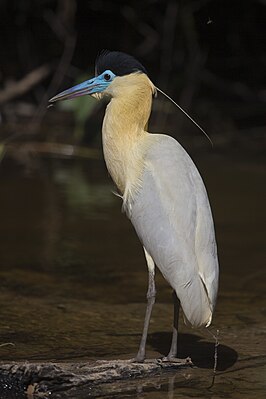Cap heron
| Cap heron | ||||||||||||
|---|---|---|---|---|---|---|---|---|---|---|---|---|

Cap heron ( pilherodius pileatus ) |
||||||||||||
| Systematics | ||||||||||||
|
||||||||||||
| Scientific name | ||||||||||||
| Pilherodius pileatus | ||||||||||||
| ( Boddaert , 1783) |
The capped heron ( Pilherodius pileatus ) is a bird art from the family of herons .
features
The cap heron reaches a body length of about 60 cm and a wingspan of about one meter. Its weight is 400 to 450 grams. Its plumage is almost completely white, only on the top of the head is a black cap. At the back of the head it has long white decorative feathers. Its featherless face is bluish in color and the long, slender beak is also bluish at the base, but becomes increasingly horn-colored to yellowish towards the tip. Its legs, rather short for a heron, are gray in color. The sexes are outwardly similar, but males are slightly larger than females.
Occurrence
Its home is the tropical and subtropical regions of America . It occurs mainly in Central America from Mexico to Panama , but also in north-central South America . There it lives mostly in swamp areas or mangroves with extensive shallow water areas, but also along rivers or shallow lakes with adjoining wet meadows. Although it is mostly found in fresh water , brackish water biotopes are also populated. Sometimes they can also be found on rice fields .
behavior
Cap herons are predominantly crepuscular. They usually hunt for small fish , amphibians , insects , worms and snails in shallow water or on wet meadows in the evening and morning hours . They are mostly solitary. Their mating season begins in most parts of the range in March or April, but later in southern ranges. During the mating season, the male performs elaborate courtship flights, during which it spreads its wings and raises its neck. They build their nests out of twigs and reeds in trees near the water. There the female lays two to three eggs , which are alternately incubated by both parents over a period of about 25 days. During this time the males are extremely territorial and defend the breeding site from conspecifics and enemies. The young birds are provided with food by both adults for about seven weeks before they leave the nest.
literature
- Steven L. Hilty : Birds of Tropical America. Vermont 1994.
- Gottfried Mauersberger, Wilhelm Meise: Urania Tierreich (7 vol.): Birds. Stuttgart 1995.
Web links
- Pilherodius pileatus in the endangered Red List species the IUCN 2011. Posted by: BirdLife International, 2009. Accessed November 13, 2011th
- Pilherodius pileatus at Arthur Grosset's Birds